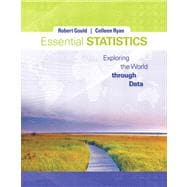
Robert L. Gould (Ph.D., University of California, San Diego) is a leader in the statistics education community. He has served as chair of the American Statistical Association’s Committee on Teacher Enhancement, has served as chair of the ASA’s Statistics Education Section, and was a co-author of the Guidelines for Assessment in Instruction on Statistics Education (GAISE) College Report. As the associate director of professional development for CAUSE (Consortium for the Advancement of Undergraduate Statistics Education), he has worked closely with the American Mathematical Association of Two-Year Colleges (AMATYC) to provide traveling workshops and summer institutes in statistics (he also presented an AMATYC summer institute in 2009). For over ten years, he has served as Vice-Chair of Undergraduate Studies at the UCLA Department of Statistics, and he is Director of the UCLA Center for the Teaching of Statistics. In 2009, Rob was elected president of the Southern California Chapter of the American Statistical Association.
Colleen N. Ryan has taught statistics, chemistry, and physics to diverse community college students for decades. She taught at Oxnard College from 1975 to 2006, where she earned the Teacher of the Year Award. Colleen currently teaches statistics part-time at California Lutheran University. She often designs her own lab activities. Her passion is to discover new ways to make statistical theory practical, easy to understand, and sometimes even fun. Colleen earned a B.A. in physics from Wellesley College, an M.A.T. in physics from Harvard University, and an M.A. in chemistry from Wellesley College. Her first exposure to statistics was with Frederick Mosteller at Harvard. In her spare time, she sings with the Oaks Chamber Singers, has been an avid skier in the past, and enjoys time with her family.
1. Introduction to Data
1.1 What Are Data?
1.2 Classifying and Storing Data
1.3 Organizing Categorical Data
1.4 Collecting Data to Understand Causality
2. Picturing Variation with Graphs
2.1 Visualizing Variation in Numerical Data
2.2 Summarizing Important Features of a Numerical Distribution
2.3 Visualizing Variation in Categorical Variables
2.4 Summarizing Categorical Distributions
2.5 Interpreting Graphs
3. Numerical Summaries of Center and Variation
3.1 Summaries for Symmetric Distributions
3.2 What's Unusual? The Empirical Rule and z-Scores
3.3 Summaries for Skewed Distributions
3.4 Comparing Measures of Center
3.5 Using Boxplots for Displaying Summaries
4. Regression Analysis: Exploring Associations between Variables
4.1 Visualizing Variability with a Scatterplot
4.2 Measuring Strength of Association with Correlation
4.3 Modeling Linear Trends
4.4 Evaluating the Linear Model
5. Modeling Variation with Probability
5.1 What is Randomness?
5.2 Finding Theoretical Probabilities
5.3 Associations in Categorical Variables
5.4 The Law of Large Numbers
6. Modeling Random Events: The Normal and Binomial Models
6.1 Probability Distributions Are Models of Random Experiments
6.2 The Normal Model
6.3 The Binomial Model
7. Survey Sampling and Inference
7.1 Learning about the World through Surveys
7.2 Measuring the Quality of a Survey
7.3 The Central Limit Theorem for Sample Proportions
7.4 Estimating the Population Proportion with Confidence Intervals
8. Hypothesis Testing for Population Proportions
8.1 The Main Ingredients of Hypothesis Testing
8.2 Characterizing p-values
8.3 Hypothesis Testing in Four Steps
8.4 Comparing Proportions from Two Populations
8.5 Understanding Hypothesis Testing
9. Inferring Population Means
9.1 Sample Means of Random Samples
9.2 The Central Limit Theorem for Sample Means
9.3 Answering Questions about the Mean of a Population
9.4 Comparing Two Population Means
9.5 Overview of Analyzing Means
10. Associations between Categorical Variables
10.1 The Basic Ingredients for Testing with Categorical Variables
10.2 Chi-Square Tests for Associations between Categorical Variables
10.3 Reading Research PapersThe New copy of this book will include any supplemental materials advertised. Please check the title of the book to determine if it should include any access cards, study guides, lab manuals, CDs, etc.
The Used, Rental and eBook copies of this book are not guaranteed to include any supplemental materials. Typically, only the book itself is included. This is true even if the title states it includes any access cards, study guides, lab manuals, CDs, etc.